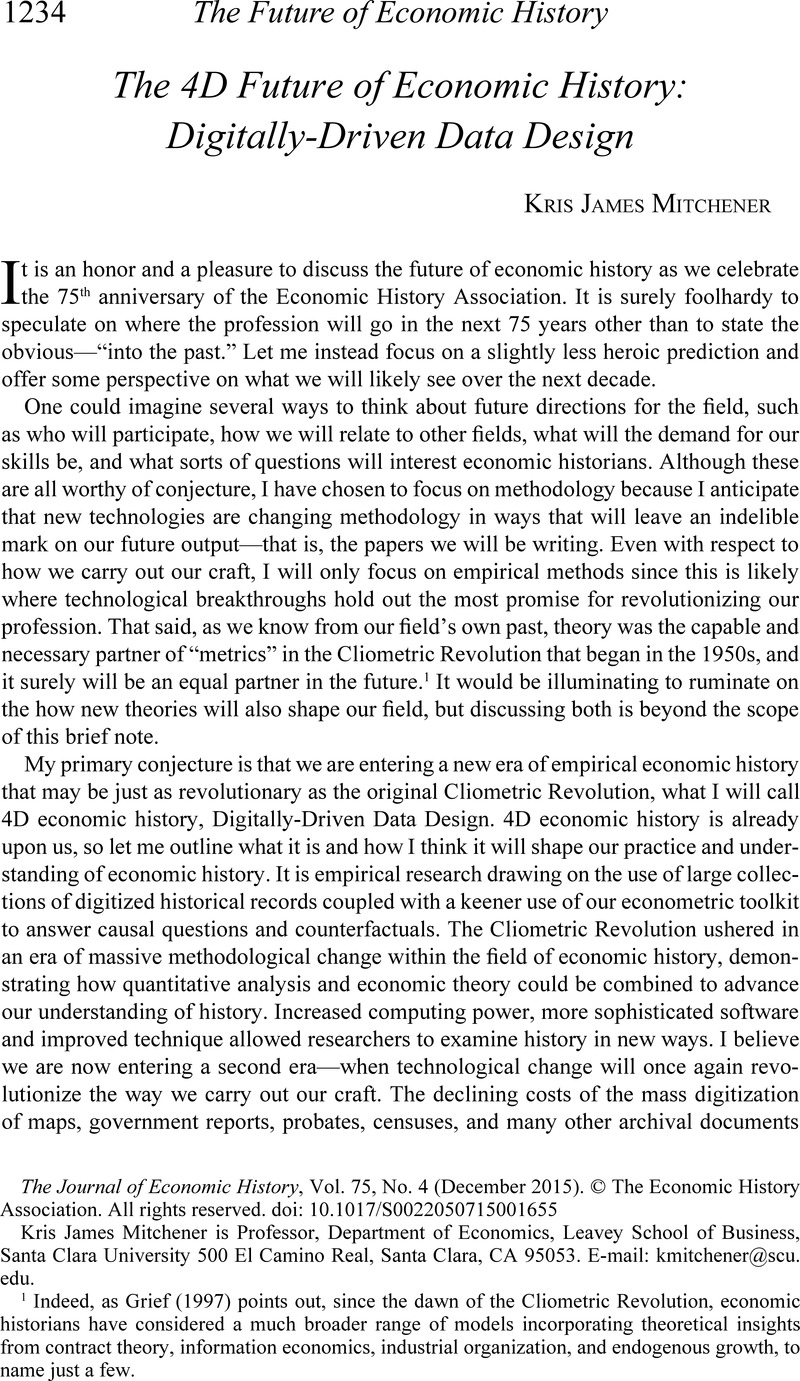Crossref Citations
This article has been cited by the following publications. This list is generated based on data provided by Crossref.
Becker, Sascha O.
Pfaff, Steven
and
Rubin, Jared
2016.
Causes and consequences of the Protestant Reformation.
Explorations in Economic History,
Vol. 62,
Issue. ,
p.
1.
Gutmann, Myron P.
Merchant, Emily Klancher
and
Roberts, Evan
2018.
“Big Data” in Economic History.
The Journal of Economic History,
Vol. 78,
Issue. 1,
p.
268.
Seltzer, Andrew J.
2018.
Publication Trends and Future Challenges for the Australian Economic History Review: A Bibliometric Analysis.
Australian Economic History Review,
Vol. 58,
Issue. 2,
p.
112.
Seltzer, Andrew J.
and
Hamermesh, Daniel S.
2018.
Co-authorship in economic history and economics: Are we any different?.
Explorations in Economic History,
Vol. 69,
Issue. ,
p.
102.
Wehrheim, Lino
2019.
Economic history goes digital: topic modeling the Journal of Economic History.
Cliometrica,
Vol. 13,
Issue. 1,
p.
83.
Becker, Sascha O.
and
Ferrara, Andreas
2019.
Consequences of forced migration: A survey of recent findings.
Labour Economics,
Vol. 59,
Issue. ,
p.
1.
Cioni, Martina
Federico, Giovanni
and
Vasta, Michelangelo
2020.
The long-term evolution of economic history: evidence from the top five field journals (1927–2017).
Cliometrica,
Vol. 14,
Issue. 1,
p.
1.
Pablo-Martí, Federico
Alañón-Pardo, Ángel
and
Sánchez, Angel
2021.
Complex networks to understand the past: the case of roads in Bourbon Spain.
Cliometrica,
Vol. 15,
Issue. 3,
p.
477.
Becker, Sascha O.
Rubin, Jared
and
Woessmann, Ludger
2021.
The Handbook of Historical Economics.
p.
585.
Monnet, Eric
and
Velde, François R.
2021.
The Handbook of Historical Economics.
p.
335.
Cantoni, Davide
and
Yuchtman, Noam
2021.
The Handbook of Historical Economics.
p.
213.
Fourie, Johan
2021.
Macroeconomic history in South Africa: The South African Reserve Bank centennial special issue.
Economic History of Developing Regions,
Vol. 36,
Issue. 2,
p.
117.
Hungerland, Wolf-Fabian
and
Wolf, Nikolaus
2022.
The panopticon of Germany’s foreign trade, 1880–1913: New facts on the first globalization.
European Review of Economic History,
Vol. 26,
Issue. 4,
p.
479.
Becker, Sascha O.
2022.
Forced Displacement in History: Some Recent Research.
SSRN Electronic Journal ,
Hanlon, W.Walker
and
Heblich, Stephan
2022.
History and urban economics.
Regional Science and Urban Economics,
Vol. 94,
Issue. ,
p.
103751.
Becker, Sascha O.
2022.
Forced displacement in history: Some recent research.
Australian Economic History Review,
Vol. 62,
Issue. 1,
p.
2.
Grajzl, Peter
and
Murrell, Peter
2023.
Handbook of Cliometrics.
p.
1.
Fernández-de-Pinedo, Nadia
La Parra-Perez, Alvaro
and
Muñoz, Félix-Fernando
2023.
Recent trends in publications of economic historians in Europe and North America (1980–2019): an empirical analysis.
Cliometrica,
Vol. 17,
Issue. 1,
p.
1.
Wehrheim, Lino
2023.
Handbook of Cliometrics.
p.
1.
Grajzl, Peter
and
Murrell, Peter
2024.
Handbook of Cliometrics.
p.
2721.



